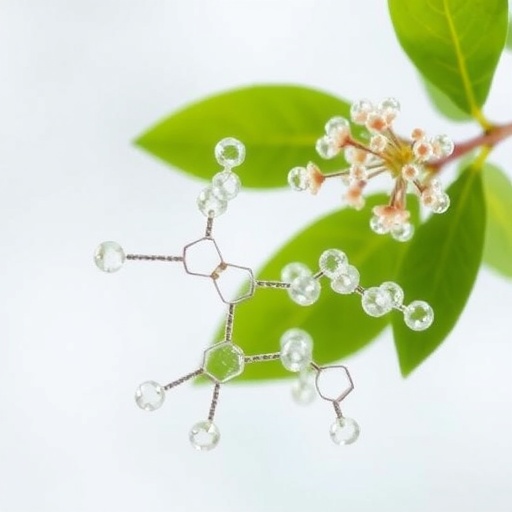In recent years, the field of nanotechnology has gained immense traction, owing largely to its potential applications across various domains, including medicine, electronics, and environmental science. One of the most promising materials emerging from this technological revolution is zinc oxide (ZnO) nanoparticles. These nanoparticles exemplify a green synthesis approach, which utilizes environmentally friendly methods to create effective nano-structures without the byproducts typically associated with conventional synthesis routes. A recent study conducted by renowned researchers Ngangom, Sharma, and Pandey sheds light on the intricate processes involved in the synthesis and characterization of ZnO nanoparticles, particularly highlighting their antibacterial properties when combined with the flavonoid naringenin.
The importance of utilizing green synthesis methods cannot be understated. Traditional chemical approaches often result in hazardous waste and toxic byproducts, posing risks not only to human health but also to environmental integrity. The transition towards greener methodologies represents a significant stride towards sustainable practices in nanotechnology. In their research, Ngangom and colleagues have successfully demonstrated that plant-derived materials, such as naringenin, can serve as both a reducing and stabilizing agent in the synthesis of ZnO nanoparticles. This innovative approach not only minimizes environmental impact but also opens new avenues for harnessing natural materials in the production of nanomaterials.
Zinc oxide has long been recognized for its diverse applications, particularly in biomedical fields. Its biocompatibility and inherent antibacterial properties make it an attractive candidate for medical applications, including drug delivery and wound healing. The synergy between ZnO nanoparticles and natural compounds like naringenin can potentially amplify these beneficial characteristics. Naringenin, a flavonoid found in various fruits, is known for its antioxidant and anti-inflammatory effects. When integrated with ZnO nanoparticles, the resulting composite may result in a formidable antimicrobial agent capable of tackling multi-drug resistant pathogens.
The characterization of ZnO nanoparticles is a critical aspect of understanding their properties and potential applications. The researchers employed a variety of advanced analytical techniques, including X-ray diffraction (XRD), scanning electron microscopy (SEM), and transmission electron microscopy (TEM), to elucidate the structural and morphological features of the synthesized nanoparticles. These techniques offer valuable insights into the crystalline structure, size, and distribution of the nanoparticles, which play a pivotal role in determining their efficacy and application scope.
One of the standout features of this study is the comprehensive assessment of the antibacterial potential of ZnO nanoparticles synthesized using naringenin. The researchers conducted a series of bioassays to evaluate the inhibitory effects of the nanoparticles against notable bacterial strains, including Escherichia coli and Staphylococcus aureus. The results revealed a pronounced antibacterial effect, showcasing the effectiveness of the ZnO-naringenin composite in impeding bacterial growth. This finding aligns with the ongoing quest in the scientific community to discover novel antibacterial agents capable of countering the rising tide of antibiotic resistance.
Additionally, the researchers explored the mechanisms underlying the antibacterial action of the ZnO nanoparticles. It is believed that the release of zinc ions coupled with the production of reactive oxygen species (ROS) plays a fundamental role in exerting the antibacterial effects. The ROS can induce oxidative stress within bacterial cells, leading to cell death. This unique mechanism distinguishes ZnO nanoparticles from conventional antibiotics, highlighting their potential in overcoming resistance mechanisms employed by pathogenic bacteria.
The implications of this research extend beyond the laboratory setting. The development of effective antibacterial agents is crucial in clinical settings, particularly in light of the increasing instances of healthcare-associated infections. The integration of ZnO nanoparticles with natural compounds like naringenin presents a promising strategy for developing new antimicrobial formulations. Furthermore, the use of green synthesis techniques aligns well with global efforts towards environmentally responsible research and production, catering to the rising demand for sustainable healthcare solutions.
In conclusion, the study by Ngangom, Sharma, and Pandey significantly contributes to the expanding body of knowledge surrounding ZnO nanoparticles and their potential applications in medicine. By leveraging green synthesis methods and exploring the antibacterial properties of ZnO nanoparticles in conjunction with naringenin, the researchers have laid the groundwork for future studies aimed at optimizing these formulations for therapeutic use. This work not only underscores the importance of innovative approaches in nanotechnology but also reinforces the vital need for sustainable practices within the scientific community.
As research continues to evolve, the potential for ZnO nanoparticles integrated with natural compounds to impact healthcare positively is substantial. Future investigations may delve deeper into the pharmacokinetics and biodistribution of these nanoparticles, potentially paving the way for their translation into clinical applications. The pathway is clear: combining the advancements in nanotechnology with eco-friendly practices could redefine the landscape of antibacterial therapies in the years to come.
This research represents a significant leap forward in our understanding and utilization of nanomaterials, showcasing how nature’s own compounds can be harnessed to drive innovation in science and medicine. By prioritizing environmental sustainability in the development of nanotechnology, the potential exists not only for novel therapeutic agents but also for a healthier planet.
In essence, the integration of ZnO nanoparticles with naringenin signifies a harmonious blend of modern science and natural products, encapsulating the future of biomedical innovation. As we anticipate the outcomes of further studies, there remains an optimistic outlook on the role of nanotechnology in addressing some of the most pressing health challenges facing humanity.
Subject of Research: Antibacterial potential of zinc oxide nanoparticles synthesized with naringenin.
Article Title: Green synthesis, characterization and antibacterial potential of zinc oxide nanoparticles with naringenin.
Article References:
Ngangom, L., Sharma, K., Pandey, N. et al. Green synthesis, characterization and antibacterial potential of zinc oxide nanoparticles with naringenin.
BMC Pharmacol Toxicol 26, 170 (2025). https://doi.org/10.1186/s40360-025-00974-4
Image Credits: AI Generated
DOI: 10.1186/s40360-025-00974-4
Keywords: zinc oxide nanoparticles, green synthesis, naringenin, antibacterial properties, nanotechnology, sustainable practices, medical applications, drug resistance.




